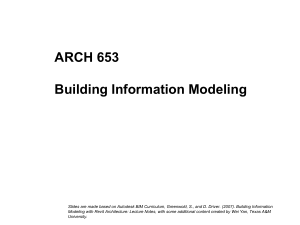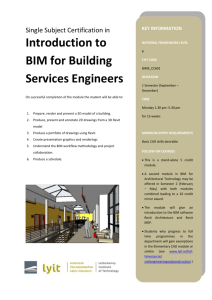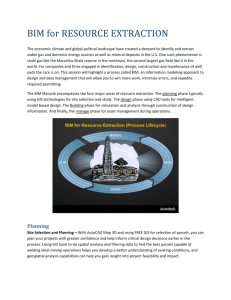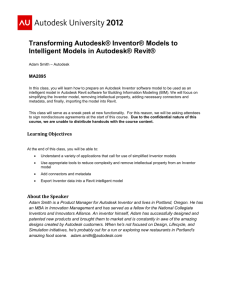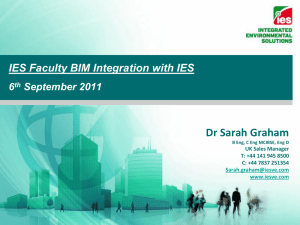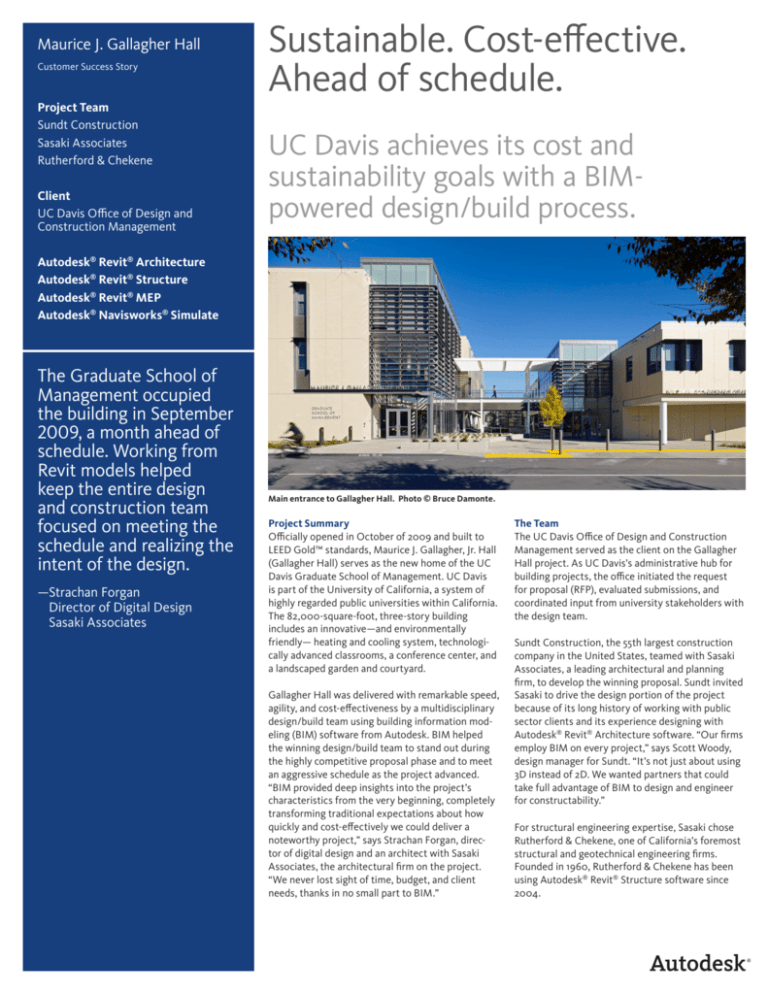
Maurice J. Gallagher Hall
Customer Success Story
Project Team
Sundt Construction
Sasaki Associates
Rutherford & Chekene
Client
UC Davis Office of Design and
­Construction Management
Sustainable. Cost-effective.
Ahead of schedule.
UC Davis achieves its cost and
sustainability goals with a BIMpowered design/build process.
Autodesk® Revit® Architecture
Autodesk® Revit® Structure
Autodesk® Revit® MEP
Autodesk® Navisworks® Simulate
The Graduate School of
Management occupied
the building in September
2009, a month ahead of
schedule. Working from
Revit models helped
keep the entire design
and construction team
focused on meeting the
schedule and realizing the
intent of the design.
—Strachan Forgan
Director of Digital Design
Sasaki Associates
Main entrance to Gallagher Hall. Photo © Bruce Damonte.
Project Summary
Officially opened in October of 2009 and built to
LEED Gold™ standards, Maurice J. Gallagher, Jr. Hall
(Gallagher Hall) serves as the new home of the UC
Davis Graduate School of Management. UC Davis
is part of the University of California, a system of
highly regarded public universities within California.
The 82,000-square-foot, three-story building
includes an innovative—and environmentally
friendly— heating and cooling system, technologically advanced classrooms, a conference center, and
a landscaped garden and courtyard.
Gallagher Hall was delivered with remarkable speed,
agility, and cost-effectiveness by a multidisciplinary
design/build team using building information modeling (BIM) software from Autodesk. BIM helped
the winning design/build team to stand out during
the highly competitive proposal phase and to meet
an aggressive schedule as the project advanced.
“BIM provided deep insights into the project’s
characteristics from the very beginning, completely
transforming traditional expectations about how
quickly and cost-effectively we could deliver a
noteworthy project,” says Strachan Forgan, director of digital design and an architect with Sasaki
Associates, the architectural firm on the project.
“We never lost sight of time, budget, and client
needs, thanks in no small part to BIM.”
The Team
The UC Davis Office of Design and Construction
Management served as the client on the Gallagher
Hall project. As UC Davis’s administrative hub for
building projects, the office initiated the request
for proposal (RFP), evaluated submissions, and
coordinated input from university stakeholders with
the design team.
Sundt Construction, the 55th largest construction
company in the United States, teamed with Sasaki
Associates, a leading architectural and planning
firm, to develop the winning proposal. Sundt invited
Sasaki to drive the design portion of the project
because of its long history of working with public
sector clients and its experience designing with
Autodesk® Revit® Architecture software. “Our firms
employ BIM on every project,” says Scott Woody,
design manager for Sundt. “It’s not just about using
3D instead of 2D. We wanted partners that could
take full advantage of BIM to design and engineer
for constructability.”
For structural engineering expertise, Sasaki chose
Rutherford & Chekene, one of California’s foremost
structural and geotechnical engineering firms.
Founded in 1960, Rutherford & Chekene has been
­using Autodesk® Revit® Structure software since
2004.
Design/build project team saves time on documentation, clash
detection, and cost analysis with BIM.
The Challenge
Before Gallagher Hall opened, the UC Davis
Graduate School of Management was housed in
a 25,000-square-foot building that had become
cramped as the top-rated school grew. In 2007, the
university’s plans for a new building were ready to
move forward, and it decided to award the building
as a unified design/build project. Susan Rainier, a
project manager in the UC Davis Office of Design
and Construction Management, explains: “In terms
of space and basic design, we had a good idea of the
kind of building we needed. We chose to leverage
our ideas about the building to facilitate a competitive bidding process that would save time and keep
costs under control.”
The Office of Design and Construction Management
wanted to take a big picture approach to awarding
the project, and it developed a detailed scoring system that would help it select the best proposal, not
simply the lowest bid. Evaluation criteria included
innovation, construction schedule, value, and adherence to the university’s sustainability goals, leading
UC Davis to specify that Gallagher Hall needed to
be built to LEED Silver™ standards.
The Solution
Throughout the proposal phase of the Gallagher
Hall project, Sundt and Sasaki used BIM solutions
from Autodesk, and both firms credit BIM with helping them to submit the winning proposal. Autodesk
Revit Architecture software helped the design
team to dive into the specifics of the design more
quickly—and deeply. Using Autodesk® Revit® MEP
and Autodesk Revit Structure software, the project
MEP and structural engineers were able to contribute cost, sustainability, and materials insights as
the proposal took shape. Vetting their design ideas
along the way, the team reviewed the proposal
model with the client in Autodesk® Navisworks®
Simulate software.
“We didn’t have much time to develop the proposal,
but being able to work from a rich, detailed model
helped to accelerate everything we did,” notes
Forgan. “In just a few days, we created a preliminary
Revit model of Gallagher Hall based on the program
outlined in the client’s RFP. Continually enhancing
and analyzing the model, we were able to more
quickly explore the cost, sustainability, and visual
implications of features.”
More Time for Innovation
According to Forgan, the additional insight afforded
by BIM inspired an innovative solution to meet UC
Davis’ sustainability goals—geothermal heating
and cooling. On examining the soil report provided
in the RFP, the team discovered that the building’s
foundation would require excavation to 16 feet, adding an unavoidable cost to the construction process.
Wanting to turn a challenge into an advantage, the
team decided to explore placing a geothermal heat
exchange under the building. The analysis made
possible by the BIM process supported this valueadd, which is not ordinarily seen in time and budget
constrained design/build projects.
No two construction
projects are ever alike, but
with BIM, we visualized
each task necessary to
complete Gallagher Hall
so that when it came time
to build, it was like we had
done it before.
—Scott Woody
Design Manager
Sundt Construction
Using Revit MEP and Revit Architecture software,
the MEP engineers, the architects, and Sundt
examined the impact of a geothermal array on
the design as a whole. Most notable, it could help
reduce the size of the heating and cooling system
by about 100 tons, with a commensurate reduction
in the cost of the equipment. They also determined
that they could scale back the amount of duct work
throughout the building by using exposed structural
slabs as the radiating surface for the geothermal
array. Because duct work is traditionally one of the
most clash-prone aspects of construction, this cut
construction risk along with costs.
“As we brainstormed, we captured input in Revit
Architecture software, and the model reflected
ideas from the engineers and the contractor as we
worked,” explains Forgan. “It enabled us to be simultaneously innovative and practical. The geothermal
array helped push our proposal high into the LEED
Gold realm. The design was also 34 percent more efficient than required by Title 24, which is California’s
strict energy efficiency standard.”
More Efficient, Accurate Cost Analysis
Sasaki needed to balance the design aesthetic with
the knowledge that cost was likely to be a major factor in winning the project. To help the team not have
to compromise on appealing features, Sasaki and
Sundt conducted real-time costing exercises using
the material take off features in Revit Architecture
software.
Rendering of the west façade of Gallagher Hall.
Marie Crist, project manager for Sundt, describes
the process: “The architects modified the façade
materials and the amount of glass in the design, and
gave us the take offs from Revit Architecture. We
then provided them with precise cost information
for their choices, helping them to stay within our
desired budget.”
“There can be a temptation to be too conservative when developing a design/build proposal,”
adds Woody. “You don’t want to drive up the bid
with extravagant features or put the firm at risk by
over-promising. We used BIM to give the team an
accurate view of how their design choices impacted
costs. For example, they didn’t have to cut back on
windows just to be on the safe side. Instead, they
were able to optimize the use of appealing features
and add value to the proposal.”
Detailed Designs in Only Eight Weeks
The design team met with stakeholders from UC
Davis early in the design process to test their initial
thoughts against client expectations. At the meeting, the team used Autodesk Navisworks Simulate
software to conduct a 3D fly-through of an early
iteration of the building model. The client stakeholders discussed the aspects of the model that
they liked and areas that did not fully address their
needs. “Following the meeting, the design team
applied the information gathered at the meeting to
our Revit-based models of Gallagher Hall,” reports
Forgan. “Prior to using Revit Architecture software,
we had to stop designing to develop a presentation for the client. Now, we can keep enhancing the
Structural rendering of Gallagher Hall.
design almost up to a deadline, and in many regards,
the documentation takes care of itself.”
Only eight weeks after receiving the RFP, Sundt and
Sasaki delivered a proposal for Gallagher Hall that
incorporated detailed renderings, plans to meet
LEED Gold standards, precise costing, and feedback
received from the client.
The UC Davis team used both cost and their scoring
systems as a guide during the selection process.
“Sundt and Sasaki’s proposal included renderings
that were very rich in detail, which was surprising
given the short amount of time they had to develop
the proposal,” says Rainier. “The design was visually
appealing, and we liked the LEED aspects. They
were definitely the point leader in the evaluation
process. Just as impressive, they were also the
lowest bidder, so awarding them the project was an
easy choice.”
Racing to the Finish
The team did not have time to celebrate winning
the Gallagher Hall project; they continued with
detailed design and began planning construction
immediately. The structural engineers at Rutherford
and Chekene developed a preliminary model in
Autodesk Revit Structure software early in the
project, which the architects were able to use as a
background in Autodesk Revit Architecture software while designing architectural details.
Courtyard view of Gallagher Hall at night.
Photo © Bruce Damonte.
Tanjeet Juneja, senior project engineer with
Rutherford & Chekene, explains how using BIM
across the team facilitated quality and collaboration
on the project. “We had a fairly complete model of
the building almost from the beginning, and we all
coordinated our work against it, correcting issues as
we went. If a beam was off by even an inch, it was
easier to spot. BIM allowed us to avoid many potential issues and clashes in advance—even before we
had won the project.”
Moving into construction well before the building documentation was complete, Sundt turned
to Autodesk Navisworks software to aggregate
the Revit-based models from the architecture and
engineering teams. As the initial site work was
underway, they began construction planning and
fabrication on the elements that were locked down,
including the geothermal array and the steel support structure.
“Reviewing the building model as a whole with
our subcontractors allowed us to communicate
exactly what we needed them to do,” says Woody.
“Sequencing features within Navisworks software
gave us the ability to break down tasks, making
it easier for crews to execute efficiently. No two
construction projects are ever alike, but with BIM,
we visualized each task necessary to complete
Gallagher Hall so that when it came time to build, it
was like we had done it before.”
Thanks to improved productivity, design team devotes more
time to developing innovative, sustainable design ideas.
The Result
The impact of BIM was evident throughout the
project, especially in meeting the schedule, notes
Forgan: “We were awarded the Gallagher Hall
project in October of 2007, began grading work in
January, and started the foundation in March. The
Graduate School of Management occupied the building in September 2009, a month ahead of schedule.
Working from Revit models helped keep the entire
design and construction team focused on meeting
the schedule and realizing the intent of the design.”
Woody reports that, from the design and construction team’s perspective, the project has been highly
successful. “From proposal development to building
to LEED Gold standards, we are pleased with what
we achieved on the project,” he says. “BIM solutions
from Autodesk enhanced the project—start to finish. BIM helps to enable the close collaboration and
insight that can make all the difference on design/
build projects.”
For More Information
Keep your public sector design/build projects on a path to success with BIM. Visit
www.autodesk.com/government to learn how.
A class taking place in one of Gallagher Hall’s classrooms. Photo © Bruce Damonte.
As we brainstormed, we captured input in Revit Architecture
software, and the model reflected ideas from the engineers
and the contractor as we worked. It enabled us to be
simultaneously innovative and practical.
—Strachan Forgan
Director of Digital Design
Sasaki Associates
Inside Gallagher Hall. Photo © Bruce Damonte.
Images courtesy of Sasaki Associates & Bruce Damonte
Autodesk, Navisworks, and Revit are registered trademarks or trademarks of Autodesk, Inc., and/or its subsidiaries and/or affiliates in the USA and/or
other countries. All other brand names, product names, or trademarks belong to their respective holders. Autodesk reserves the right to alter product
and services offerings, and specifications and pricing at any time without notice, and is not responsible for typographical or graphical errors that may
appear in this document. © 2010 Autodesk, Inc. All rights reserved.


